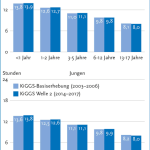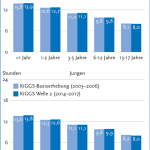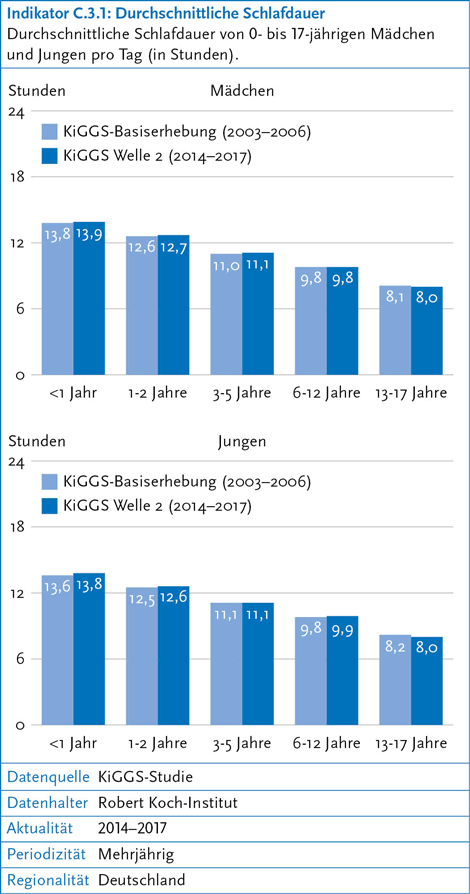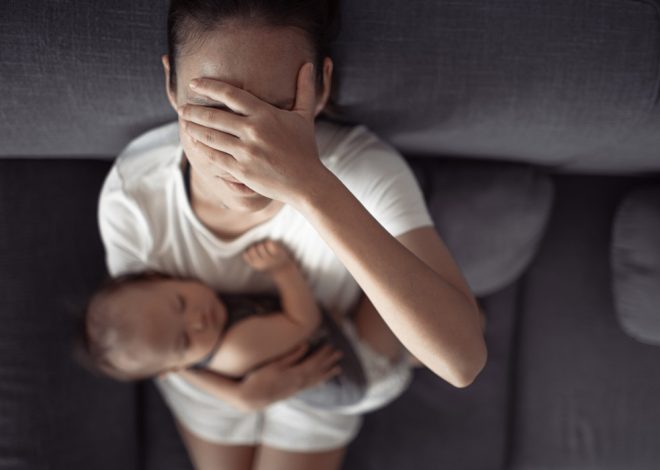
RKI – Behavior – Topic sheet: Sleep



central message
- Loud KiGGS In Wave 2 (2014–2017), 81% of children and adolescents achieved the age-specific recommended sleep duration.
- In adolescence, the proportion of those who achieve age-specific sleep recommendations decreases
- Boys and girls achieve the age-specific sleep recommendations at approximately equal rates.
background
Sufficient sleep is important for the healthy development of children and adolescents [1, 2]. The sleep needs of adolescents decrease with age and can also differ between peers [3]. Numerous studies have shown that children and adolescents who sleep little have an increased risk of obesity [4-7]This connection, which is particularly true for adolescents with a higher body mass index (BMI), [8]various explanatory mechanisms are discussed. On the one hand, the increased risk of obesity in children and adolescents who sleep little is attributed to hormonal and metabolic effects of the short sleep duration, which can lead to an increased appetite and thus to an increased energy intake [6]On the other hand, lack of sleep can be associated with a reduced body temperature, which can reduce energy requirements and promote a positive energy balance [7]Last but not least, lack of sleep leads to tiredness, which can have a negative impact on physical activity and thus on energy consumption. The fact that more food can be consumed during longer periods of wakefulness is also discussed as a possible cause for the observed connection.
Indicators and data sources
Indicators are the average sleep duration of 0- to 17-year-old girls and boys (indicator C.3.1) and the proportion of 0- to 17-year-old girls and boys who sleep at least as much as the AASM recommends (indicator C.3.2). The data source is the “Study on the Health of Children and Adolescents in Germany” (KiGGS study) of the Robert Koch Institute (RKI), which is based on a nationwide population-representative sample of residents’ registration offices and provides cross-sectional and longitudinal data on the health situation of children and adolescents. [10]The reported data come from the KiGGS baseline survey (2003–2006) and the KiGGS Wave 2 (2014–2017) [11]Information on sleeping habits was collected using a questionnaire that was completed by the children and adolescents (11- to 17-year-olds) or by their parents (0- to 10-year-olds).
Results
According to KiGGS Wave 2 (2014–2017), children and adolescents aged 0 to 17 sleep an average of 10.0 hours per day (indicator C.3.1). With increasing age, the average sleep duration decreases from 13.9 hours for children under 1 year old to 8.0 hours for 13 to 17 year olds. Boys and girls do not differ significantly in the average sleep duration in any age group, neither in the KiGGS baseline survey (2003–2006) nor in the KiGGS Wave 2 (2014–2017). Further analyses of the data from the KiGGS baseline survey (2003–2006) show that the average sleep duration decreases with increasing age, even within the age groups shown. [12].


According to KiGGS Wave 2 (2014-2017), 81% of children and adolescents sleep at least as much as the AASM recommends (indicator C.3.2). In the 13- to 17-year-old age group, the proportion is significantly lower at 60% than in the younger age groups, where around 90% of children achieve the age-specific sleep recommendations. The proportions of boys and girls who achieve the sleep recommendations differ only slightly in all age groups. Compared to the KiGGS baseline survey (2003-2006), this proportion has fallen significantly among 13- to 17-year-olds. In the other age groups, no significant differences can be observed between the two surveys in this regard.


Classification of the results
The results of the KiGGS study show that most children and adolescents in Germany meet the age-specific sleep recommendations. However, the proportion of those who sleep less than recommended by professional associations increases during adolescence. When interpreting the results, it must be taken into account that these are self-reported data. It cannot be ruled out that the results are influenced by memory errors or social desirability (i.e. response behavior in which respondents are more likely to give the answer they believe will be met with approval). [13]) are distorted. In addition, it must be noted that the amount of sleep required varies greatly from person to person, meaning that those who achieve the recommended amount of sleep may not get enough sleep, while those who do not achieve the recommended amount of sleep may get enough sleep. Last but not least, sleep quality also plays an important role in the health effects of sleep. [1, 2]. In view of the importance of sleep for the healthy development of children and adolescents and the prevention of obesity, care should be taken to ensure that children and adolescents get enough sleep and as little disruption as possible. Plenty of outdoor exercise and avoiding sleep disruptors, such as eating large meals or using electronic screen media shortly before going to bed, can make an important contribution to this. [14].
Infobox: Recommendations on sleep duration
Recommendations of the American Academy of Sleep Medicine (AASM) on sleep duration for children and adolescents [9]:
– 4 to 12 months: 12 to 16 hours per day
– 1 to 2 years: 11 to 14 hours per day
– 3 to 5 years: 10 to 13 hours per day
– 6 to 12 years: 9 to 12 hours per day
– 13 to 17 years: 8 to 10 hours per day
literature
- Spruyt K (2019) A review of developmental consequences of poor sleep in childhood. Sleep Medicine 60:3-12
- Matricciani L, Paquet C, Galland B et al. (2019) Children’s sleep and health: a meta-review. Sleep Medicine Reviews 46:136-150
- Chaput JP, Dutil C, Sampasa-Kanyinga H (2018) Sleeping hours: what is the ideal number and how does age impact this? Nature and Science of Sleep 10:421
- Miller MA, Kruisbrink M, Wallace J et al. (2018) Sleep duration and incidence of obesity in infants, children, and adolescents: a systematic review and meta-analysis of prospective studies. Sleep 41(4):1-19
- Wu YH, Gong QH, Zou ZQ et al. (2017) Short sleep duration and obesity among children: a systematic review and meta-analysis of prospective studies. Obesity Research and Clinical Practice 11(2):140-150
- Felso R, Lohner S, Hollody K et al. (2017) Relationship between sleep duration and childhood obesity: systematic review including the potential underlying mechanisms. Nutrition Metabolism and Cardiovascular Diseases 27(9):751-761
- Li L, Zhang S, Huang YB et al. (2017) Sleep duration and obesity in children: a systematic review and meta-analysis of prospective cohort studies. Journal of Paediatrics and Child Health 53(4):378-385
- Bayer O, Rosario AS, Wabitsch M et al. (2009) Sleep duration and obesity in children: is the association dependent on age and choice of the outcome parameter? Sleep 32(9):1183-1189
- Paruthi S, Brooks LJ, D’Ambrosio C et al. (2016) Recommended amount of sleep for pediatric populations: a consensus statement of the American Academy of Sleep Medicine. Journal of Clinical Sleep Medicine 12(6):785
- Kurth BM, Kamtsiuris P, Hölling H et al. (2008) The challenge of comprehensively mapping children’s health in a nation-wide health survey: design of the German KiGGS-Study. BMC Public Health 8:196
- Mauz E, Gößwald A, Kamtsiuris P et al. (2017) New data for action. The data collection for KiGGS Wave 2 has ended. Journal of Health Monitoring 2(S3):2-28
- Schlarb A, Gulewitsch MD, Weltzer V et al. (2015) Sleep duration and sleep problems in a representative sample of German children and adolescents. Health 7(11):1397-1408
- Diekmann A (2009) Empirical social research: fundamentals, methods, applications. Rowohlt Verlag, Hamburg
- German Society for Sleep Research and Sleep Medicine (DGSM) (2018) Patient guide of the DGSM AG Pediatrics: Sleep disorders in infants, toddlers, children and adolescents. www.dgsm.de/downloads/patienteninformationen/ratgeber/DGSM%20Ratgeber%202018/DRUCK_Schlafst%C3%B6rungen%20bei%20S%C3%A4uglingen,%20Kleinkindern,%20Kindern%20und%20Jugendlichen%202019-02-06.pdf (as of: May 14, 2020)

Ethel Purdy – Medical Blogger & Pharmacist
Bridging the world of wellness and science, Ethel Purdy is a professional voice in healthcare with a passion for sharing knowledge. At 36, she stands at the confluence of medical expertise and the written word, holding a pharmacy degree acquired under the rigorous education systems of Germany and Estonia.
Her pursuit of medicine was fueled by a desire to understand the intricacies of human health and to contribute to the community’s understanding of it. Transitioning seamlessly into the realm of blogging, Ethel has found a platform to demystify complex medical concepts for the everyday reader.
Ethel’s commitment to the world of medicine extends beyond her professional life into a personal commitment to health and wellness. Her hobbies reflect this dedication, often involving research on the latest medical advances, participating in wellness communities, and exploring the vast and varied dimensions of health.
Join Ethel as she distills her pharmaceutical knowledge into accessible wisdom, fostering an environment where science meets lifestyle and everyone is invited to learn. Whether you’re looking for insights into the latest health trends or trustworthy medical advice, Ethel’s blog is your gateway to the nexus of healthcare and daily living.



